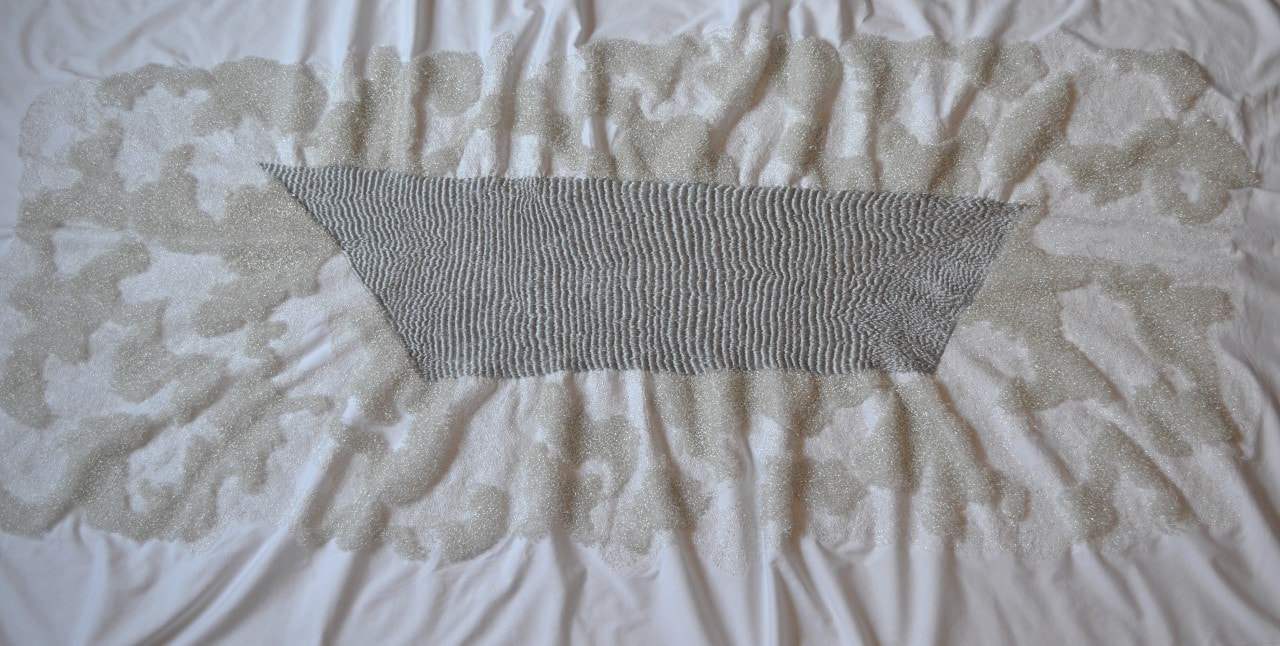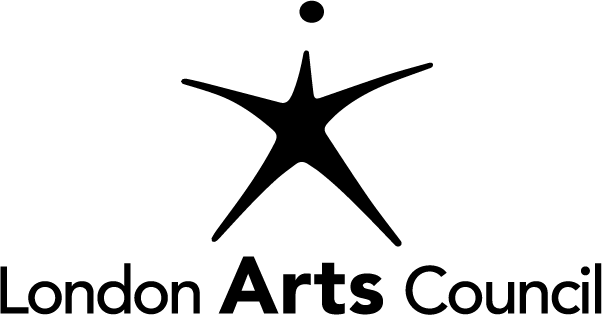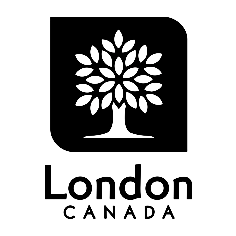The Monolithic Boat, Bunka and hand-embroidery on fabric, 2019, 213 cm x 91 cm
ECH: Tell us a little about yourself.
I was born and brought up in West Bengal, India. I grew up seeing my father practicing painting and pottery. I have lived in the southern and western part of India for my higher study and work. I travelled to the UK to do an artist residency program at the Newcastle University for three months after being awarded the Charles Wallace India Award in 2013. That was an extraordinary experience that inspired and motivated me to travel and understand my studio practice. I came to London, Ontario, to pursue my MFA at Western University in 2016. Since then, I am living and practicing art in the city.
ECH: Briefly describe your practice.
My studio practice includes research on the idea of mobility, temporality and the process of hand-embroidery. Culture, mapping, personal identity, labour, and landscapes have emerged as key issues in my ongoing artistic practice. Working with textile sourced from diverse cultures and places is fundamental to my research, as it made me aware of their historical significance and their adaptation in contemporary art. I have used recycled fabric from thrift stores in London, Ontario, discarded fabric from my family in West Bengal and other parts of India, and tarpaulin in my embroidery work. My interest in both studio practice and theoretical research helps me to articulate, question and develop my growing interest in hand-embroidery and engage with the notion of embellishment as a concept.
ECH: What role does your cultural identity play in your work?
Cultural identity lies at the core of my studio practice. My thematic area and material exploration are thoroughly inspired by my personal experience and cultural history. Moving to Canada and studying at Western University made me aware of its significance and became a vital area of my artistic research. I needed to unlearn and to learn a lot about almost every aspect of living here. That created for me an experience where the feeling of being in a new place started seeping into my artwork, and it began to raise questions about identity, local and personal history, memory, archives, mapping and many more concepts.
ECH: As a person of colour, what challenges do you face navigating the art world?
I never felt that I had experienced challenges navigating the art world being a person of colour so far. I want to consider this on a positive note. I am not sure even if I had been through one without realizing! London’s art community is warm and welcoming. However, people asked about my caste and religion when I moved to western India while looking for a room to rent back in 2010.
ECH: Could you share a little bit about your experience during the pandemic?
The pandemic is a highly crucial and affecting phase in most of our lives, and it’s not over yet. I am not an exception. I was lucky to visit my family in India in early 2020 after three and half years and was able to return to Canada just before everything went under lockdown.
The pandemic made me think through the interdependence and coexistence between humans and nature. It also led my attention to the Anthropocene and how artists respond to this idea/concept. It has been a learning period in many ways. I had to learn how to use some software to communicate online, which brought some challenges initially. However, I took online communication much more seriously to effectively deliver art sessions and attended many seminars and talks while staying at home. I am presently focusing on finishing a few projects with the deadline of August 2021.
ECH: If any, can you tell us about your connection/experience/history with the Embassy Culture House?
I was introduced to Embassy Culture House by artist Jamelie Hassan when she invited me to share my work earlier this year. I met her for the first time in 2016 when I was studying at Western University. She was one of my external examiners. Jamelie Hassan and Ron Benner are two significant connecting figures for me with the artist community in London and beyond. I am and always will be thankful to them for all their support and encouragement in my art and life. I am truly honoured to be a part of this long history of ECH and its growing artist, researcher and creative community.
I was born and brought up in West Bengal, India. I grew up seeing my father practicing painting and pottery. I have lived in the southern and western part of India for my higher study and work. I travelled to the UK to do an artist residency program at the Newcastle University for three months after being awarded the Charles Wallace India Award in 2013. That was an extraordinary experience that inspired and motivated me to travel and understand my studio practice. I came to London, Ontario, to pursue my MFA at Western University in 2016. Since then, I am living and practicing art in the city.
ECH: Briefly describe your practice.
My studio practice includes research on the idea of mobility, temporality and the process of hand-embroidery. Culture, mapping, personal identity, labour, and landscapes have emerged as key issues in my ongoing artistic practice. Working with textile sourced from diverse cultures and places is fundamental to my research, as it made me aware of their historical significance and their adaptation in contemporary art. I have used recycled fabric from thrift stores in London, Ontario, discarded fabric from my family in West Bengal and other parts of India, and tarpaulin in my embroidery work. My interest in both studio practice and theoretical research helps me to articulate, question and develop my growing interest in hand-embroidery and engage with the notion of embellishment as a concept.
ECH: What role does your cultural identity play in your work?
Cultural identity lies at the core of my studio practice. My thematic area and material exploration are thoroughly inspired by my personal experience and cultural history. Moving to Canada and studying at Western University made me aware of its significance and became a vital area of my artistic research. I needed to unlearn and to learn a lot about almost every aspect of living here. That created for me an experience where the feeling of being in a new place started seeping into my artwork, and it began to raise questions about identity, local and personal history, memory, archives, mapping and many more concepts.
ECH: As a person of colour, what challenges do you face navigating the art world?
I never felt that I had experienced challenges navigating the art world being a person of colour so far. I want to consider this on a positive note. I am not sure even if I had been through one without realizing! London’s art community is warm and welcoming. However, people asked about my caste and religion when I moved to western India while looking for a room to rent back in 2010.
ECH: Could you share a little bit about your experience during the pandemic?
The pandemic is a highly crucial and affecting phase in most of our lives, and it’s not over yet. I am not an exception. I was lucky to visit my family in India in early 2020 after three and half years and was able to return to Canada just before everything went under lockdown.
The pandemic made me think through the interdependence and coexistence between humans and nature. It also led my attention to the Anthropocene and how artists respond to this idea/concept. It has been a learning period in many ways. I had to learn how to use some software to communicate online, which brought some challenges initially. However, I took online communication much more seriously to effectively deliver art sessions and attended many seminars and talks while staying at home. I am presently focusing on finishing a few projects with the deadline of August 2021.
ECH: If any, can you tell us about your connection/experience/history with the Embassy Culture House?
I was introduced to Embassy Culture House by artist Jamelie Hassan when she invited me to share my work earlier this year. I met her for the first time in 2016 when I was studying at Western University. She was one of my external examiners. Jamelie Hassan and Ron Benner are two significant connecting figures for me with the artist community in London and beyond. I am and always will be thankful to them for all their support and encouragement in my art and life. I am truly honoured to be a part of this long history of ECH and its growing artist, researcher and creative community.



















